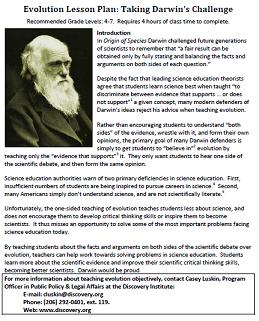 Education
Education
Back to School Lesson Plans That Actually Help Students Understand Evolution
 The taxpayer-funded “Evolution Readiness Project” seeks to “teach young children how Darwin’s model of natural selection explains the observation that organisms are adapted to their environment” in hopes that they will “believe in” evolution. The project offers a variety of lesson plans which are just as bad as the book Life on Earth: The Story of Evolution, a primary resource the project recommends which I critiqued in previous posts (see Part 1, Part 2, Part 3, Part 4, and Part 5).
The taxpayer-funded “Evolution Readiness Project” seeks to “teach young children how Darwin’s model of natural selection explains the observation that organisms are adapted to their environment” in hopes that they will “believe in” evolution. The project offers a variety of lesson plans which are just as bad as the book Life on Earth: The Story of Evolution, a primary resource the project recommends which I critiqued in previous posts (see Part 1, Part 2, Part 3, Part 4, and Part 5).
As we’ve seen, this project promotes a decidedly one-sided view of evolution. What would it look like to teach students about evolution in an objective fashion, which follows the proscription of leading science educators to teach students about both the “evidence that supports … or does not support” a theory?
The NSF spent $1,990,459 of taxpayer dollars on a project that dumbs-down evolution to the point where fourth graders will accept a dogmatic, but false, version of Darwin’s ideas. For a $2.50 cup of caffeinated tea, and couple hours one night at the local Starbucks, I was able to create a lesson plan,” posted below, that teachers can use to teach pre-high school students about evolution in an objective fashion. The PDF can be seen here and it is titled “Taking Darwin’s Challenge.” The introduction to the lesson plan is posted below:
In Origin of Species Darwin challenged future generations of scientists to remember that “a fair result can be obtained only by fully stating and balancing the facts and arguments on both sides of each question.”
Despite the fact that leading science education theorists agree that students learn science best when taught “to discriminate between evidence that supports … or does not support”1 a given concept. However, many modern defenders of Darwin’s ideas reject his advice when teaching evolution.
Rather than encouraging students to understand “both sides” of the evidence, wrestle with it, and form their own opinions, the primary goal of many Darwin defenders is simply to get students to “believe in”2 evolution by teaching only the “evidence that supports”3 it. They only want students to hear one side of the scientific debate, and then form the same opinion.
Science education authorities warn of two primary deficiencies in science education. First, insufficient numbers of students are being inspired to pursue careers in science.4 Second, many Americans simply don’t understand science, and are not scientifically literate.5
Unfortunately, the one-sided teaching of evolution teaches students less about science, and does not encourage them to develop critical thinking skills or inspire them to become scientists. It thus misses an opportunity to solve some of the most important problems facing science education today.
By teaching students about the facts and arguments on both sides of the scientific debate over evolution, teachers can help work towards solving problems in science education. Students learn more about the scientific evidence and improve their scientific critical thinking skills, becoming better scientists. Darwin would be proud.
References Cited:
[1.] See Jonathan Osborne, “Arguing to Learn in Science: The Role of Collaborative, Critical Discourse,” Science, Vol. 328 (5977): 463-466 (April 23, 2010).
[2.] See About the Evolution Readiness Project (“it is unacceptable that 150 years after the birth of the theory of evolution only four out of ten Americans believe in it!”).
[3.] See Evolution Readiness Project Grant Award (“This project will use computer-based models of interacting organisms and their environments to support a learning progression leading to an appreciation of the theory of evolution and evidence that supports it”).
[4.] See National Science Board, “The Science and Engineering Workforce: Realizing America’s Potential,” p. 7 (August 14, 2003) and National Science Foundation, “An Emerging and Critical Problem of the Science and Engineering Workforce: A Companion to Science and Engineering Indicators 2004” (2004).
[5.] Many authorities recognize this problem. For one example, see America’s Lab Report: Investigations in High School Science, p. 1 (National Research Council, 2006).
